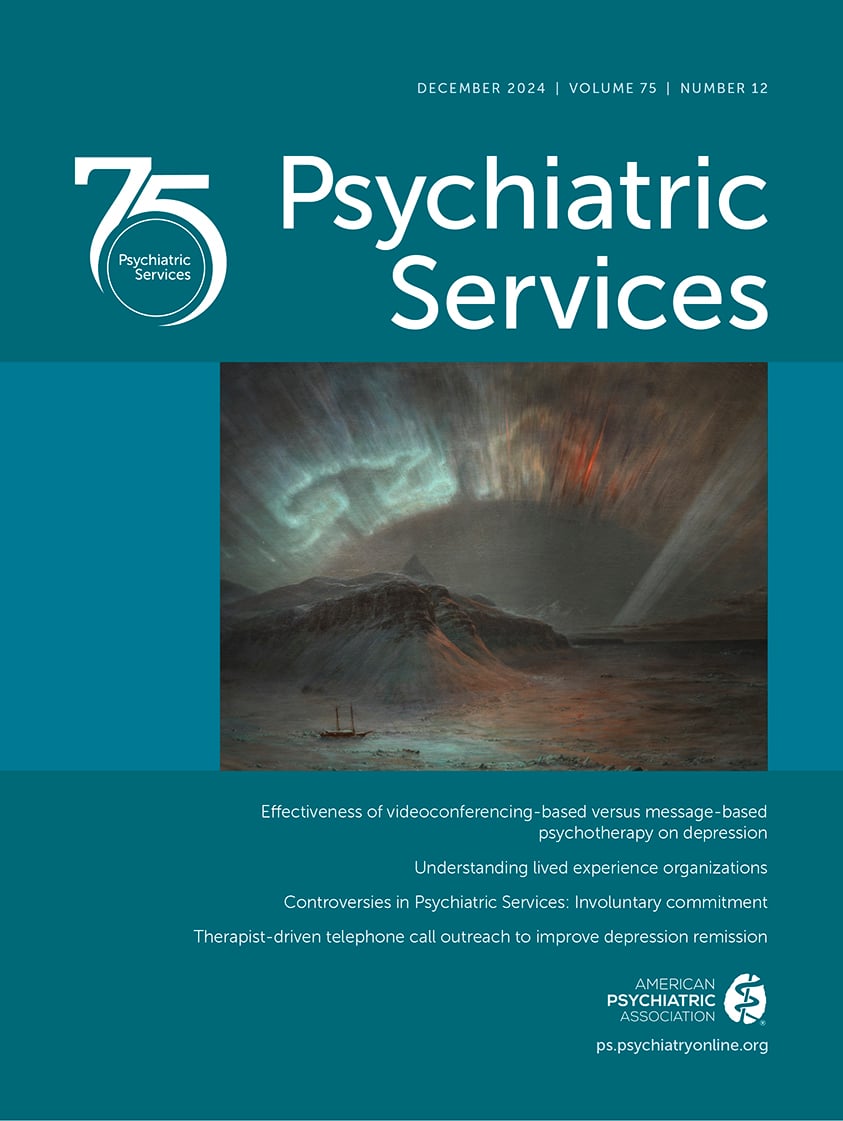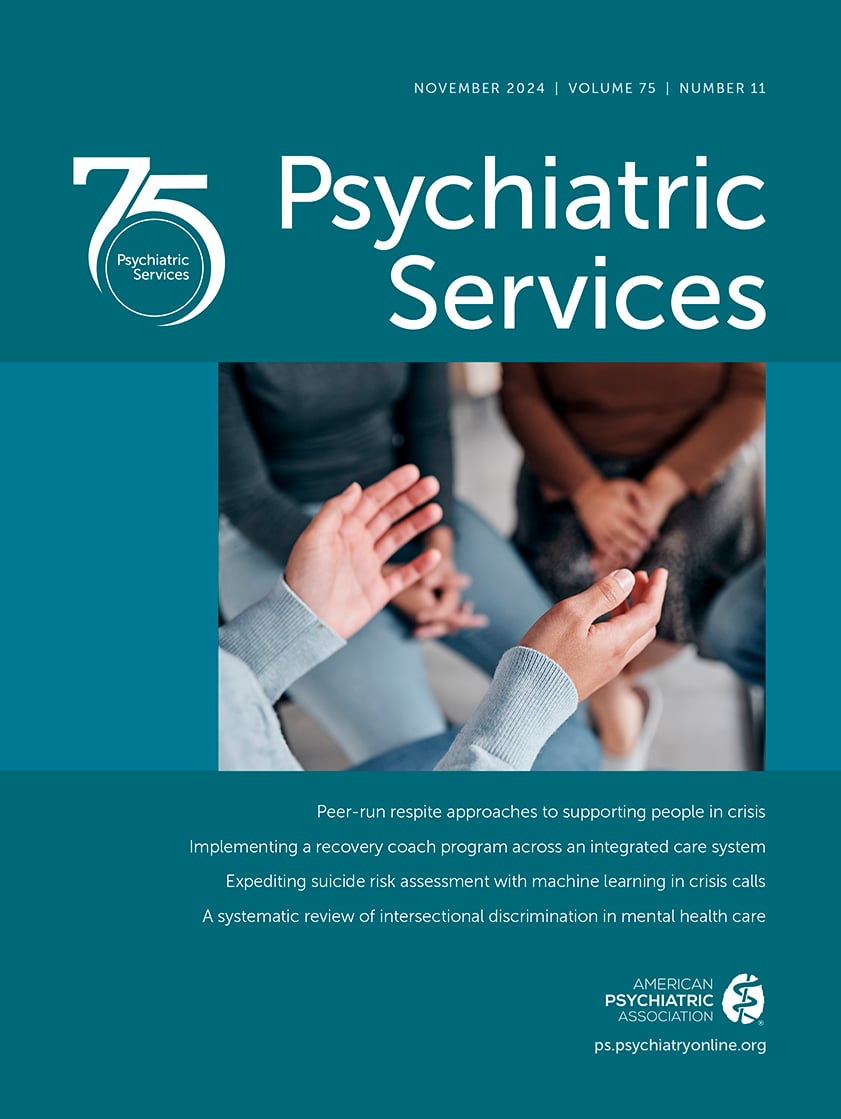Psychiatric Services
- Volume 49
- Number 10
- October 1998
Taking Issue
Column
Publication date: 01 October 1998
Pages1273–1290Introduction by the column editor Any health care system that provides care to individuals in the context of a budget for a population must establish priorities for allocating resources. Establishing priorities is ultimately a process of questioning our ...
https://doi.org/10.1176/ps.49.10.1273Article
Publication date: 01 October 1998
Pages1303–1308This paper examines temporal changes in staffing ratios and configuration of mental health providers per 100,000 members within two full- service staff-model health maintenance organizations (HMOs). Overall workforce reductions in all classes of mental ...
https://doi.org/10.1176/ps.49.10.1303Publication date: 01 October 1998
Pages1309–1312Because psychiatrists cannot include everything they observe and everything the patient says in the medical chart, they must select and tailor what goes into the chart. They should tailor the chart to focus on what is significant for the diagnosis and ...
https://doi.org/10.1176/ps.49.10.1309Publication date: 01 October 1998
Pages1313–1316OBJECTIVE: The study evaluated the effects of a brief manualized treatment program that taught patients skills to re-enter the community and actively follow through with their own care. METHODS: A total of 59 recently admitted inpatients with ...
https://doi.org/10.1176/ps.49.10.1313Publication date: 01 October 1998
Pages1317–1322OBJECTIVE: Community-based treatment of persons with serious mental illness requires providers to become involved in clients' personal lives to a greater degree than does hospital-based treatment. The study examined attendant ethical dilemmas, especially ...
https://doi.org/10.1176/ps.49.10.1317Publication date: 01 October 1998
Pages1323–1329OBJECTIVE: This study sought information about the effect of managed care on substance abuse treatment programs through a survey of program directors. METHODS: Fifty program directors who supervised a total of 134 substance abuse treatment programs in Los ...
https://doi.org/10.1176/ps.49.10.1323Publication date: 01 October 1998
Pages1330–1337OBJECTIVE: The study tested the hypothesis that case management provided to mentally ill offenders both in jail and after release from jail would reduce their recidivism. METHODS: A total of 261 inmates of the Lucas County (Toledo, Ohio) jail who were ...
https://doi.org/10.1176/ps.49.10.1330APA Achievement Awards
Brief Report
Publication date: 01 October 1998
Pages1347–1350Recidivism is a widely used quality indicator for inpatient substance abuse care. However, unadjusted recidivism rates do not account for important confounding variables, which may lessen their usefulness as a quality indicator. Using a study of a ...
https://doi.org/10.1176/ps.49.10.1347Publication date: 01 October 1998
Pages1350–1352This study examined factors associated with engagement in outpatient treatment of patients with dual diagnoses of psychiatric disorder and substance use disorder. The charts of all 57 patients referred to a dual diagnosis treatment program during a six-...
https://doi.org/10.1176/ps.49.10.1350Publication date: 01 October 1998
Pages1353–1355This study explored the association between psychosocial variables and symptoms among patients with schizophrenia-spectrum disorders who have attempted suicide and those who have not attempted suicide. Of 336 patients with a DSM-III-R diagnosis of ...
https://doi.org/10.1176/ps.49.10.1353Publication date: 01 October 1998
Pages1355–1357In a prospective open-label study, the substitution of immediate-release valproic acid for divalproex sodium was evaluated in the treatment of 47 adult psychiatric inpatients who had been stabilized on divalproex for at least one month. After two weeks, ...
https://doi.org/10.1176/ps.49.10.1355Unusual Case Report
Publication date: 01 October 1998
Pages1358–1359The authors report the case of a patient who developed hyperammonemia and coma during therapy with valproic acid for affective disorder. Onset of the coma was gradual and initially interpreted as a therapeutic reduction in the patient's anxiety. In a ...
https://doi.org/10.1176/ps.49.10.1358Letter
Book Review: Is It Bogus, or Is It Not?
Book Review
Past Issues
View Issues Archive
Vol. 75 | No. 12

Vol. 75 | No. 11

Vol. 75 | No. 10
